Here is my sister’s blog post about her camping trip to and her experiences with the Pocono Mountinas / Hickory Run State Park / the Boulder Field / the Shades of Death Trail. My sister Katie and her husband hiked the Shades of Death Trail and visited the massive Boulder Field with their five-year-old and their three-year-old.
Category: Ghost Towns
Fire History
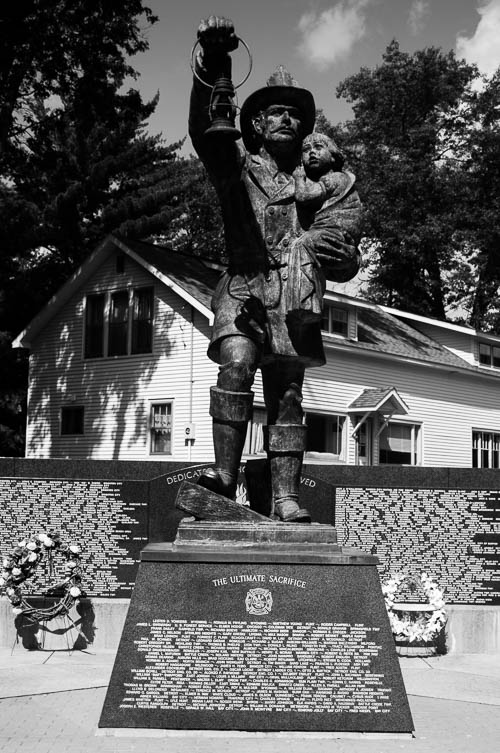
A few years ago, my husband Jonathan and I visited the Michigan Fireman’s Memorial in Roscommon, Michigan. I took the above photo at this memorial. I post it tonight in honor of the following dates:
September 29 – October 6, 2019: Light the Night for Fallen Firefighters
October 6 – October 12, 2019: Fire Prevention Week
October 8-10, 1871: Great Chicago Fire
October 8, 1871: Peshtigo, Wisconsin Fire
October 8, 1871: major fires in Holland, Manistee, and Port Huron, Michigan
October 9, 1871: major fire in Urbana, Illinois
October 12, 1871: major fire in Windsor, Ontario
In honor of Chicago and its firefighters, here is a photo that I took of a Chicago fire boat:
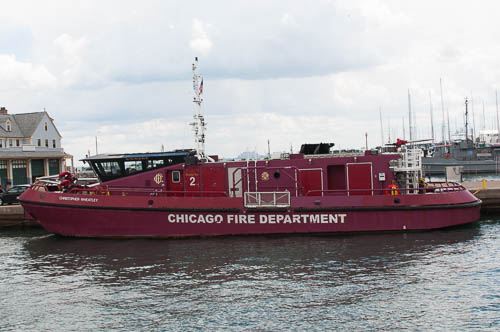
Here’s a little story for you: I learned on Wikipedia that a town by the name of Singapore, Michigan ONCE existed on the shoreline of Lake Michigan. Singapore became a ghost town as a result of the October 1871 fires, but it DIDN’T burn.
Singapore, MI was founded in 1836. The town included two sawmills. As one might expect of a town that has sawmills, a forest bordered Singapore.
Well, the fires produced such a great demand for lumber that the businessmen in Singapore deforested the area surrounding Singapore. With the trees gone, the town had no protection from Lake Michigan’s sand dunes. By 1875, the town was covered up by sand!
In my opinion, this is the premise of a Margaret Atwood story.
Stay fire safe this month.
“What Did the Romans Ever do for Us?”
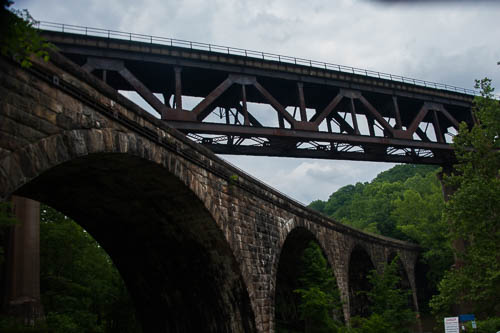
The English language is inane. I just Googled the capitalization rules from three different style books in order to type the title for this blog post. I’m still not sure if I have the capitalization correct. I couldn’t just Google the phrase itself because this phrase comes from a much longer sentence in Monty Python’s “The Life of Brian.”
Anyway, the ancient Romans engineered arch bridges.
You can picnic underneath the pictured stone arch bridge at Tunnelview Historic Site in Western PA (near Saltsburg).
The Pennsylvania Railroad (PRR) built the stone arch bridge in 1907.
This bridge crosses the Conemaugh River on the side of Bow Ridge. This bridge replaced two other bridges and aqueducts at this river crossing. The bridge survived the Johnstown Flood of 1936. The Army Corps of Engineers built the Conemaugh Dam nearby in 1952 for flood control. This stone bridge no longer holds railroad tracks, but it now provides access to the dam’s east side.
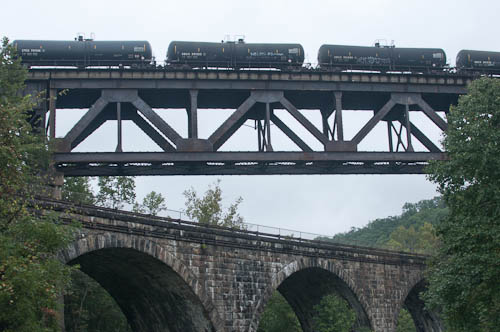
The iron bridge that passes over the stone arch bridge IS a currently active railroad bridge. I took the above photo as a freight train carrying crude oil crossed the bridge and also crossed the Conemaugh River. Keep in mind that the Conemaugh feeds the Kiski River. The Kiski feeds the Allegheny River. The Allegheny feeds the Ohio River. The Ohio feeds the Mississippi River. Think about this as you watch a train full of crude oil traverse the Conemaugh.
Both of the bridges at Bow Ridge cross the Conemaugh River downstream from the dam.
If you cross the stone arch bridge to access Bow Ridge, you will see the remains of the Bow Ridge Tunnel. The ghost town of Livermore, Pennsylvania sits beyond this tunnel, on the other side of Bow Ridge. (The government partially flooded Livermore when they built the Conemaugh Dam and created Conemaugh Lake.)
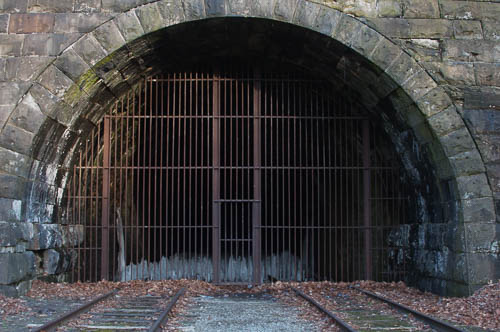
This is very close to the boundary between Indiana County and Westmoreland County. You can reach this by driving through the Conemaugh Lake National Recreation Area, or from the West Penn Trail.
If you access the Tunnelview Historic Site through the entrance to Conemaugh Lake National Recreation Area, you will see this fantastic sign:
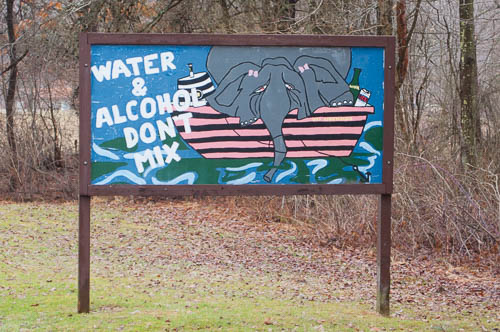
Here- at the Tunnelview Historic Site – you will find a small pavilion, primitive restroom, parking lot, and canoe put-in. You will also see remains of the Pennsylvania Mainline Canal. This is where Jonathan and I put-in when we kayaked to Saltsburg twice.
Oh! I have to tell you about the FIRST time Jonathan and I kayaked from here:
We parked here at the Tunnelview Historic Site. We paddled downstream six miles, almost to Saltsburg. We stopped for lunch. It was June, and the current didn’t “seem” all that strong. As per our plan, we set off to paddle upstream back to our car.
Hey, I think that we have been paddling next to that same rock for the past ten minutes. What the – when did the current get that strong?
That’s right – we couldn’t paddle upstream. We portaged our kayaks upriver for a good part of the return trip. We smelled a dead animal rotting in the water. Jonathan didn’t tell me about the snakes that swam past us because snakes scare me. I worried that we wouldn’t get back to our car before the sun set, that we would have to spend the night in the woods, and that somebody would find our car and report us as missing on the river. As I pulled my kayak over the stones on the riverback, I fantasized about the search party that would be sent after us, about our faces all over the news. (We did get back to our car and get the kayaks loaded right before it got dark.)
In hindsight, we should have paddled to Saltsburg, then hired the canoe outfitter in Saltsburg to take us upriver to our car. We talked about doing this when we realized that we couldn’t paddle against the current. Why didn’t we? Because we’re stubborn.
On our second trip, we parked in Saltsburg and let the outfitter drive us to the put-in at the Tunnelview Historic Site. Then we paddled downriver to our car. Much better.
Life is easier when we aren’t stubborn.
Here is the sign that SHOULD have tipped us off that the Conemaugh River’s current “might” be sorta strong at our put-in spot:
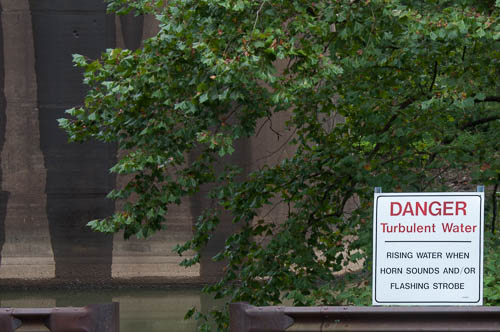
Here’s another important sign:
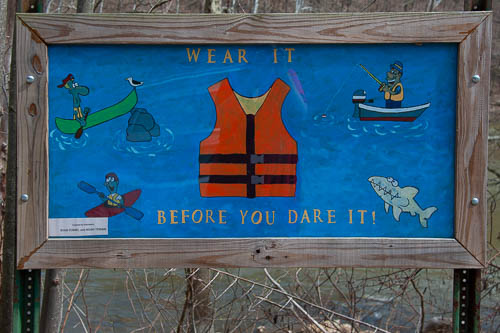
(Here is a close-up of the artist names:)
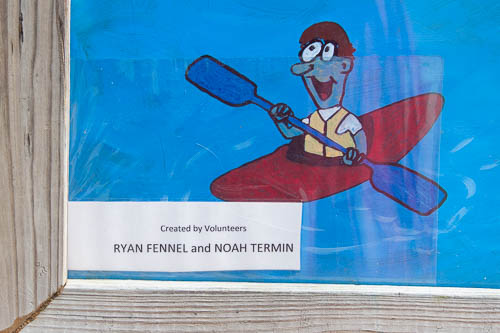
We haven’t picnicked at Tunnelview or kayaked on the Conemaugh River for a while because we’ve spent so much time this year with the “new” sailboat. However, I really think that you would enjoy your visit to Tunnelview.
As I noted, the remains of the canal and aqueduct at this site were part of the Pennsylvania Mainline Canal, which worked in a system with the Allegheny Portage Railroad. From the 1830’s – 1850’s, this system hauled boats over the Allegheny Mountains. Pennsylvania paid to construct the entire thing. Then, after about only two decades, the system became obsolete! I WILL blog about this on some future day.
(This is a redux from the blog that I created with my husband Jonathan, www.jennyandjonathangetmarried.com. I will shortly pull more of my favorite stories out from the crypt. I want to share more of my favorite moments and places with you fantastic readers.)